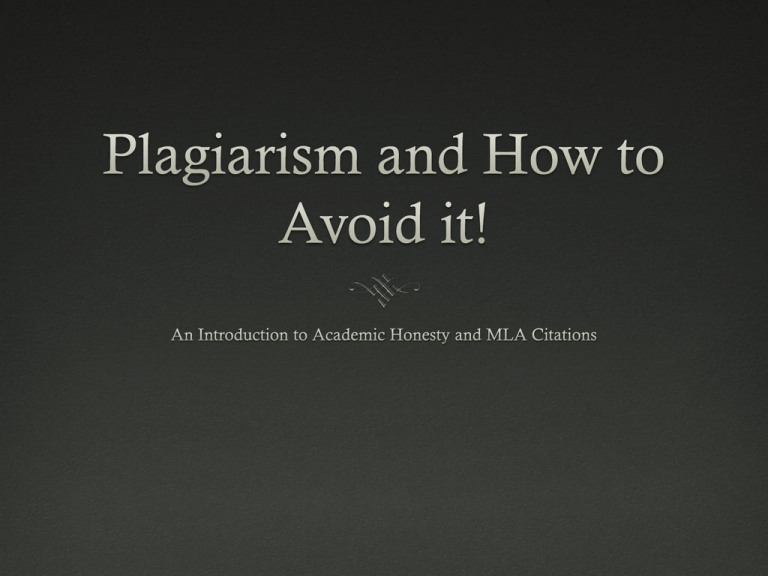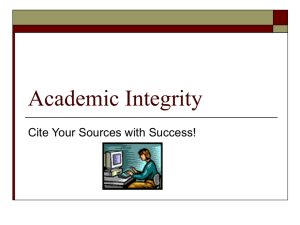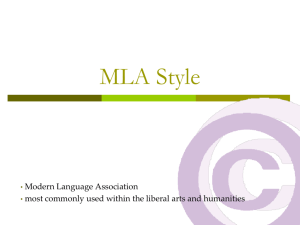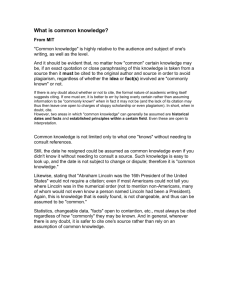Plagiarism and How to Avoid it! - Iredell
advertisement

Bell Ringer #27 What is plagiarism? What are some ways plagiarism can be avoided? Why should we promote “academic honesty” (not cheating and recognizing others for their work) at Northview? http://tinypic.com/view.php?pic=5btzbr&s=6#.VGpkjUtB3bo Reluctant God Summative Assessment You will be creating a brochure about Ancient Egypt. You will have some flexibility with the content of your brochure, and how you make connections to the novel. You must conduct research on your selected topics using the databases provided by the school district, print books from the media center, and reputable internet links. You must have a minimum of THREE sources (1 print, 1 electronic database, 1 internet site) These must be cited in MLA format and attached to your brochure You must also submit a book review of the novel Research Question and Plan A break down of due dates: You will be selecting a research question (example: what kinds of clothing did ancient Egyptians wear) to help guide you in your research. This question will be due at the end of next class (time will be provided in class) You will need to get source cards for all three sources Due next week after research time in class and Media Center Final Product must be printed and turned in by 12/17 or 12/18 depending on your class day Understanding Our IB Rubrics We will be creating a task-specific rubric to align with our IB rubrics What this means is that we will see what the IB folks say, then give specific examples of what it would look like in your travel brochure I will divide you into groups Each group will have four minutes to decide what each level of achievement would look like, and what the difference would be between the numbers in the same category (i.e. what does a four look like verses a five) We will type up and post our rubric on my website. I am going to hold you to the standards that you set for yourselves! Group Roles 5 Groups, I’ll be counting off by fives First Round= Leader-Keep everyone on task and make sure every voice is heard Second Round=Recorder-Writes down what the group comes up with on poster Third Round=Presenter-Presents product to the class Fourth Round=Time Keeper-Keeps an eye on time and on task Fifth Round= Errand Monitor-Gets supplies and asks questions as needed Regardless of role, EVERYONE in the group is responsible for completing the task! Don’t be: “I’m the presenter, so I’ll just loaf around until we present.” (Groups of four will combine Time Keeper and Errand Monitor) Kahoot! Open your MacBooks and go to kahoot.it Enter this as your game pin: 135595 Pick a school appropriate nickname Pick the shape of the best answer to the following questions about plagiarism The winner will receive… Prize will be revealed on next slide What is Plagiarism? Definition: The practice of taking someone else's work or ideas and passing them off as one's own. Essentially, if you take credit for someone else’s work, it is considered cheating. In college you can be expelled and “blacklisted” and in the professional world you could get in legal trouble. We avoid plagiarism by giving credit to the source of our information by citing our sources! Is it Plagiarism if… I copy and paste something word for word? I copy and paste but I cite my source? I read something for information but put it in my own words without citing it? I turn in a paper I didn’t write? YES! These are all examples of plagiarism. When to Cite When you quote something, you must give credit by citing your source. When you copy something word-for-word, you must give credit by citing your source along with quotation marks. When you paraphrase someone's ideas, you must give them credit by citing your source When you summarize someone's ideas, you must give them credit by citing your source When not to Cite Original ideas or research Common knowledge Things that are easily observed Common sayings/clichés Citation Styles There are many ways to cite your sources You will be using the MLA Format At the end of your project, you will submit of copy of your Bibliography to me How to Use MLA I am listing the steps, citations are always written like a sentence (see example below) For a book Author’s Last Name, Author’s First Name. Title of Book. City of publication: Name of publisher, Year. Medium. (What it is made of ?) Pentzak, Joseph. Why Is Mr. Pentzak So Awesome? Statesville: Northview Press, 2014. Print. How to Use MLA Magazine Article Author’s Last Name, Author’s First Name. “Title of Article.” Name of periodical. Day Month (abrv). Year. Medium. Date Accessed (if web) <URL (website link)> Carter, Shawn. "I Discovered My 100th Problem." Fake Lyfe 1 Apr. 2012. Web. <http://www.fakelyfe123.com> How to Use MLA Website Author and/or editor names (if available) “Article Title.” Title of the Website. Any version numbers available, including revisions, posting dates, volumes, or issue numbers. Publisher Name. Medium. Date you accessed the material. <URL> Aristotle. “Poetics.” Trans. S. H. Butcher. The Internet Classics Archive. Web Atomic and Massachusetts Institute of Technology, 13 Sept. 2007. Web. 4 Nov. 2008. ‹http://classics.mit.edu/› Citing Pictures Okay, so you really are supposed to cite photos. For this project, I will allow you to cite them by giving the full URL under the image. http://img.pandawhale.com/post-36437-doge-meme-weather-8h04.jpeg “I can’t find…” Sometimes you will not find all the citation information Step one: double check somewhere else! Step two: “n.p.” for no publisher or “n.d.” for no date, leave author blank if there is no identified author Step three: if you cannot find ANY information about the source, do you think it is a good, reliable source? NOPE! Ditch it and find a better one! Quick Reminders Punctuation ALWAYS goes inside quotation marks (example: Mr. Pentzak yelled, “YOLO!” and he jumped out of the moving van. OR Mrs. Newton confessed, “Mr. Pentzak is the coolest teacher ever.” Do not indent the first line of a citation, if it goes onto a second line, indent that one. This is what that looks like: Do not indent the first line of a citation, if it goes onto a second line, indent that one. Citation builder websites may not always be correct. Always write citations yourself! If we have time Plagiarism game: http://www.lycoming.edu/library/instruction/tutorial s/plagiarismGame.aspx Homework Get familiar with MLA citations and how we put information together to make citations Go to this website and play until you win two rounds https://www.lib.jmu.edu/tictactoe/ Take a screenshot of each “You Won!” screens You can use this document to help you as you play: https://depts.washington.edu/trio/quest/citation/apa_ mla_citation_game/MLA_Review_09.pdf Select your Three Topics By now, you should be familiar with the content of our research databases You need to select three related topics to include in your brochure You will use these topics to write your research question Formulate a Research Question Using your three topics, craft a question that will be answered by your research. Example for climate, agriculture, and food: “How did the climate of Egypt effect the agricultural methods of ancient farmers and the types of food they produced and ate?” Closely related topics may only need one question. You may choose to write multiple questions. Your research question needs to guide your research Your research needs to answer that question, final product is the answer to the question You need to explain why you picked that question(s) Personal connections Compare/contrast modern to ancient They answer: why should I/audience care? Why do we want to know? You should NOT be able to answer this question today! Bell Ringer #28 Take out your completed research questions, three index cards, your binder, a pencil and your macbooks Respond to the following questions in your bell ringer section: 1. What have I completed on my project so far? 2. What do I hope to get accomplished in today’s class period? 3. What more needs to be done? 4. Which portion of the project are you having the most difficult with? (Finding sources, citing sources, formatting brochure, book review, etc.) Source Cards On an index card write the number of your source (one, two or three) in the upper left corner Write your name, date and block in the upper right corner On the top line, write the type of source (database article, book/ebook, or website) Write out the FULL MLA citation Write the facts you are using from that source in your own words or the quotes you will be pulling from that source One will be counted as a classwork grade and the other two will be counted as homework grades (CW due today, two for HW due next class) Example # Type of Source (Book) Name Date Block Full MLA citation ex: Last, First. Title is in italics. City: Publisher, Year. Medium. (Second line is indented) The facts you are using from this source paraphrased (restated in your own words) go here. You should pull about three facts from each source. You’ll probably be able to find more if it is a good source. Feel free to continue writing on the back of your source card! If you cannot find at least three facts from a source it most likely isn’t the best one to be using. Remember to refer back to your research question to help guide your research. Works Cited The Purdue OWL. Purdue U Writing Lab, 2010. Web. 17 Nov. 2014. https://owl.english.purdue.edu/owl/resource/747/01/> Citing Your Sources. Oxford College Library. Web. 17 Nov. 2014. http://oxford.library.emory.edu/research-learning/citationplagiarism/citing.html > This is PP and the formatting is slightly off





